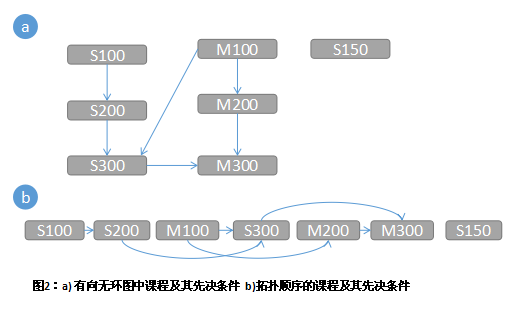广度优先(bfs)和深度优先搜索(dfs)的应用实例
一、广度优先搜索应用举例:计算网络跳数
图结构在解决许多网络相关的问题时直到了重要的作用。
比如,用来确定在互联网中从一个结点到另一个结点(一个网络到其他网络的网关)的最佳路径。一种建模方法是采用无向图,其中顶点表示网络结点,边代表结点之间的联接。使用这种模型,可以采用广度优先搜索来帮助确定结点间的最小跳数。
如图1所示,该图代表Internet中的6个网络结点。以node1作为起点,有不止1条可以通往node4的路径。<node1,node2,node4>,<node1,node3,node2,node4>,<node1,node3,node5,node4>都是可行的路径。广度优先搜索可以确定最短路径选择,即<node1,node2,node4>,一共只需要两跳。

我们以bfs作为广度优先搜索的函数名(见示例1及示例2)。该函数用来确定互联网中两个结点之间的最小跳数。这个函数有3个参数:graph是一个图,在这个问题中就代表整个网络;start代表起始的顶点;hops是返回的跳数链表。函数bfs会修改图graph,因此,如果有必要的话在调用该函数前先对图创建拷贝。另外,hops中返回的是指向graph中实际顶点的指针,因此调用者必须保证只要访问hops,graph中的存储空间就必须保持有效。
graph中的每一个顶点都是一个BfsVertex类型的结构体(见示例1),该结构体有3个成员:data是指向图中顶点的数据域指针,color在搜索过程中维护顶点的颜色,hops维护从起始顶点开始到目标顶点的跳数统计。
match函数是由调用者在初始化graph时作为参数传递给graph_init的。match函数应该只对BfsVertex结构体中的data成员进行比较。
bfs函数将按照前面介绍过的广度优先搜索的方式来计算。为了记录到达每个顶点的最小跳数,将每个顶点的hop计数设置为与该顶点邻接的顶点的hop计数加1。对于每个发现的顶点都这样处理,并将其涂成灰色。每个顶点的颜色和跳数信息都由邻接表结构链表中的BfsVertex来维护。最后,加载hops中所有跳数未被标记为-1的顶点。这些就是从起始顶点可达的顶点。
bfs的时间复杂度为O(V+E),这里V代表图中的顶点个数,E是边的个数。这是因为初始化顶点的颜色属性以及确保起始顶点存在都需要O(V)的运行时间,广度优先搜索中的循环的复杂度是O(V+E),加载跳数统计链表的时间为O(V)。
示例1:广度优先搜索的头文件
/*bfs.h*/
#ifndef BFS_H
#define BFS_H
#include "graph.h"
#include "list.h"
/*定义广度优先搜索中的顶点数据结构*/
typedef struct BfsVertex_
{
????????void *data;
????????VertexColor color;
????????int hops;
}BfsVertex;
/*函数接口定义*/
int bfs(Graph *graph, BfsVertex *start, List *hops);
#endif // BFS_H
?示例2:广度优先搜索的实现
/*bfs.c*/
#include <stdlib.h>
#include "bfs.h"
#include "graph.h"
#include "list.h"
#include "queue.h"
/*bfs */
int bfs(Graph *graph, BfsVertex *start, List *hops)
{
????????Queue queue;
????????AdjList *adjlist, *clr_adjlist;
????????BfsVertex *clr_vertex, *adj_vertex;
????????ListElmt *element, *member;
????????/*初始化图中的所有结点为广度优先结点*/
????????for(element = list_head(&graph_adjlists(graph)); element != NULL; element = list_next(element))
????????{
????????????????clr_vertex = ((AdjList *)list_data(element))->vertex;
????????????????if(graph->match(clr_vertex,start))
????????????????{
????????????????????????/*初始化起始顶点*/
????????????????????????clr_vertex->color = gray;
????????????????????????clr_vertex->hops = 0;
????????????????}
????????????????else
????????????????{
????????????????????????/*初始化非起始顶点*/
????????????????????????clr_vertex->color = white;
????????????????????????clr_vertex->hops = -1;
????????????????}
????????}
????????/*初始化队列,并将起始顶点的邻接表入队*/
????????queue_init(&queue,NULL);
????????/*返回起始顶点的邻接表,存储到clr_adjlist*/
????????if(graph_adjlist(graph,start,&clr_adjlist) != 0)
????????{
????????????????queue_destroy(&queue);
????????????????return -1;
????????}
????????/*将顶点的邻接表入队到队列*/
????????if(queue_enqueue(&queue,clr_adjlist) != 0 )
????????{
????????????????queue_destroy(&queue);
????????????????return -1;
????????}
????????/*执行广度优先探索*/
????????while(queue_size(&queue) > 0)
????????{
????????????????adjlist = queue_peek(&queue);
????????????????/*遍历邻接表中的每一个顶点*/
????????????????for(member = list_head(&adjlist->adjacent); member != NULL; member = list_next(member))
????????????????{
????????????????????????adj_vertex = list_data(member);
????????????????????????/*决定下一个邻接点的颜色*/
????????????????????????if(graph_adjlist(graph,adj_vertex,&clr_adjlist) != 0)
????????????????????????{
????????????????????????????????queue_destroy(&queue);
????????????????????????????????return -1;
????????????????????????}
????????????????????????clr_vertex = clr_adjlist->vertex;
????????????????????????/*把白色的顶点标成灰色,并把它的邻接顶点入队*/
????????????????????????if(clr_vertex->color == white)
????????????????????????{
????????????????????????????????clr_vertex->color = gray;
????????????????????????????????clr_vertex->hops = ((BfsVertex *)adjlist->vertex)->hops + 1;
????????????????????????????????if(queue_enqueue(&queue,clr_adjlist) != 0)
????????????????????????????????{
????????????????????????????????????????queue_destroy(&queue);
????????????????????????????????????????return -1;
????????????????????????????????}
????????????????????????}
????????????????}
????????????????/*将当前顶点邻接表从队列中移除并涂成黑色*/
????????????????if(queue_dequeue(&queue,(void **)&adjlist) == 0)
????????????????{
????????????????????????((BfsVertex *)adjlist->vertex)->color = black;
????????????????}
????????????????else
????????????????{
????????????????????????queue_destroy(&queue);
????????????????????????return -1;
????????????????}
????????}
????????queue_destroy(&queue);
????????/*返回每一个顶点的hop计数到一个链表中*/
????????list_init(hops,NULL);
????????for(element = list_head(&graph_adjlists(graph)); element != NULL; element = list_next(element))
????????{
????????????????/*跳过那些没有被访问到的节点(hops = -1)*/
????????????????clr_vertex = ((AdjList *)list_data(element))->vertex;
????????????????if(clr_vertex->color != -1)
????????????????{
????????????????????????if(list_ins_next(hops,list_tail(hops),clr_vertex) != 0)
????????????????????????{
????????????????????????????????list_destroy(hops);
????????????????????????????????return -1;
????????????????????????}
????????????????}
????????}
????????return 0;
}
二、深度优先搜索的应用举例:拓扑排序
有时候,我们必须根据各种事物间的依赖关系来确定一种可接受的执行顺序。比如,在大学里必须满足一些先决条件才能选的课程,或者一个复杂的项目,其中某个特定的阶段必须在其他阶段开始之前完成。要为这一类问题建模,可以采用优先级图,其采用的是有向图的思路。在优先级图中,顶点代表任务,而边代表任务之间的依赖关系。以必须先完成的任务为起点,以依赖于此任务的其他任务为终点,画一条边即可。
如下图所示,它表示7门课程及其先决条件组成的一份课程表:S100没有先决条件,S200需要S100,S300需要S200和M100,M100没有先决条件,M200需要M100,M300需要S300和M200,并且S150没有先决条件同时也不是先决条件。

通过对这些课程执行拓扑排序,深度优先搜索有助于确定出一中可接受的顺序。
拓扑排序将顶点排列为有向无环图,因此所有的边都是从左到右的方向。正规来说,有向无环图G=(V,E)的拓扑排序是其顶点的一个线性排序,以便如果G中存在一条边(u,v),那么线性顺序中u出现在v的前面,在许多情况下,满足此条件的顺序有多个。
下面的代码示例实现了函数dfs,即深度优先搜索。该函数在这里用来对任务做拓扑排序。dfs有两个参数:graph代表图,在这个问题中则代表需要排序的任务;而参数ordered是完成拓扑排序后返回的顶点链表。调用该函数会修改图graph,因此如果有必要需要在调用前先对graph创建一个副本。另外,函数返回后链表ordered中保存了指向图graph中顶点的指针,因此调用者必须保证,一旦访问ordered中的元素就必须保证graph中的存储空间保持有效。graph中的每一个顶点都是一个DfsVertex结构体,该结构体拥有两个成员:data是指向顶点数据域部分的指针;而color在搜索过程中负责维护顶点的颜色信息。match函数是由调用者在初始化graph时通过参数传递给graph_init的,该函数应该只对DfsVertex结构体中的data成员进行比较。
dfs按照深度优先的方式进行搜索。dfs_main是实际执行搜索的函数。dfs中的最后一个循环保证对图中所有未相连的元素完成了检索。在dfs_main中逐个完成顶点的搜索并将其涂黑,然后插入链表ordered的头部。最后,ordered就包含完整拓扑排序后的顶点。
dfs的时间复杂度是O(V+E),V代表图中的顶点个数,而E代表边的个数。这是因为初始化顶点的颜色信息需要O(V)的时间,而dfs_main的时间复杂度为O(V+E)。
示例3:深度优先搜索的头文件
/*dfs.h*/
#ifndef DFS_H
#define DFS_H
#include "graph.h"
#include "list.h"
/*为深度优先搜索中的所有节点定义一个结构体*/
typedef struct DfsVertex_
{
????????void *data;
????????VertexColor color;
}DfsVertex;
/*公共接口*/
int dfs(Graph *graph,List *ordered);
#endif // DFS_H
示例4:深度优先搜索的函数实现
/*dfs.c*/
#include <stdlib.h>
#include "dfs.h"
#include "graph.h"
#include "list.h"
/*dfs_main*/
static int dfs_main(Graph *graph, AdjList *adjlist, List *ordered)
{
????????AdjList *clr_adjlist;
????????DfsVertex *clr_vertex, *adj_vertex;
????????ListElmt *member;
????????/*首先,将起始顶点涂成灰色,并遍历它的邻接顶点集合*/
????????((DfsVertex *)adjlist->vertex)->color = gray;
????????for(member = list_head(&adjlist->adjacent); member != NULL; member = list_next(member))
????????{
????????????????/*决定下一个集合顶点的颜色*/
????????????????adj_vertex = list_data(member);
????????????????if(graph_adjlist(graph,adj_vertex,&clr_adjlist) != 0)
????????????????{
????????????????????????return -1;
????????????????}
????????????????clr_vertex = clr_adjlist->vertex;
????????????????/*如果当前顶点是白色,则递归搜索它的邻接点*/
????????????????if(clr_vertex->color == white)
????????????????{
????????????????????????if(dfs_main(graph,clr_adjlist,ordered) != 0)
????????????????????????????????return -1;
????????????????}
????????}
????????/*把当前顶点涂成“黑”色,并加入到链表头部*/
????????((DfsVertex *)adjlist->vertex)->color = black;
????????if(list_ins_next(ordered, NULL, (DfsVertex *)adjlist->vertex) !=0 )
????????????????return -1;
????????return 0;
}
/*dfs*/
int dfs(Graph *graph, List *ordered)
{
????????DfsVertex *vertex;
????????ListElmt *element;
????????/*初始化图中的所有顶点*/
????????for(element = list_head(&graph_adjlists(graph)); element != NULL; element = list_next(element))
????????{
????????????????vertex = ((AdjList *)list_data(element))->vertex;
????????????????vertex->color = white;
????????}
????????/*执行广度优先搜索*/
????????list_init(ordered,NULL);
????????for(element = list_head(&graph_adjlists(graph)); element != NULL; element = list_next(element))
????????{
????????????????/*确保图中的每个顶点都能被检索到*/
????????????????vertex = ((AdjList *)list_data(element))->vertex;
????????????????if(vertex->color == white)
????????????????{
????????????????????????if(dfs_main(graph, (AdjList *)list_data(element), ordered) != 0)
????????????????????????{
????????????????????????????????list_destroy(ordered);
????????????????????????????????return -1;
????????????????????????}
????????????????}
????????}
????????return 0;
}??
本文来自互联网用户投稿,该文观点仅代表作者本人,不代表本站立场。本站仅提供信息存储空间服务,不拥有所有权,不承担相关法律责任。 如若内容造成侵权/违法违规/事实不符,请联系我的编程经验分享网邮箱:chenni525@qq.com进行投诉反馈,一经查实,立即删除!
- Python教程
- 深入理解 MySQL 中的 HAVING 关键字和聚合函数
- Qt之QChar编码(1)
- MyBatis入门基础篇
- 用Python脚本实现FFmpeg批量转换
- vue3.0 router路由跳转传参
- Docker(十三)底层实现
- 【JavaEE进阶】 关于Maven
- Elasticsearch各种文档操作2
- Docker实战09|使用AUFS包装busybox
- 接口测试简介及用例设计
- python数据可视化之折线图案例讲解
- 【C语言基础篇】结构控制(下)转向语句break、continue、goto、return
- Java:常见算法
- 【开源软件】最好的开源软件-2023-第七名 Redwood